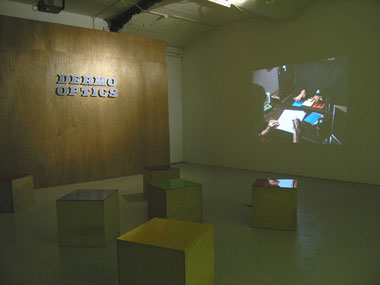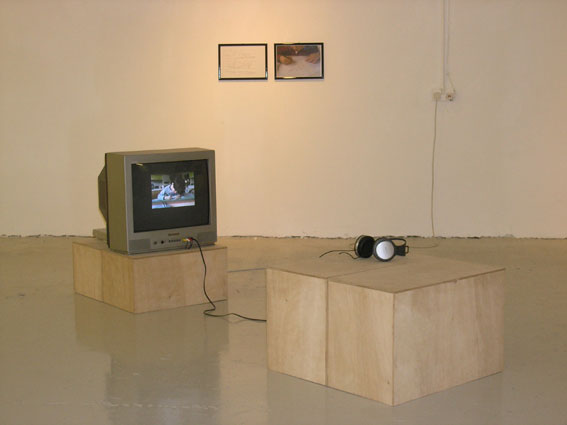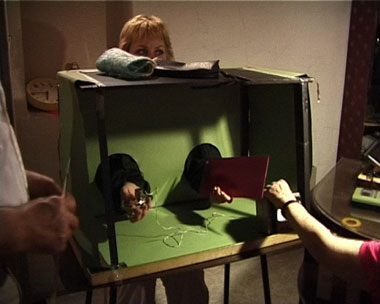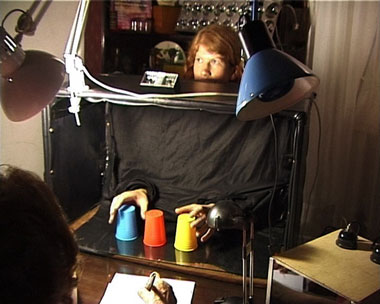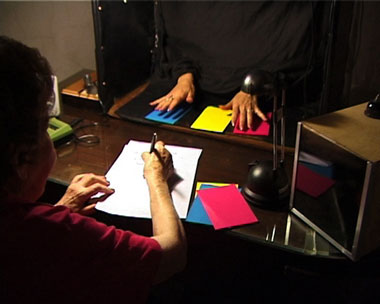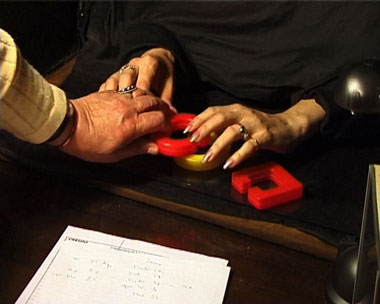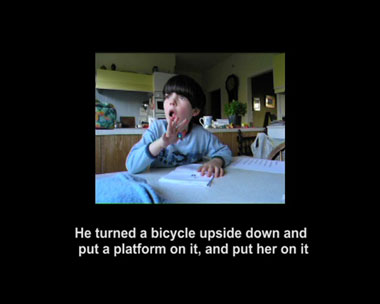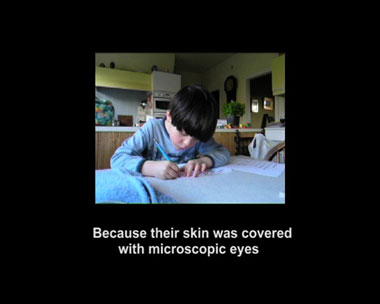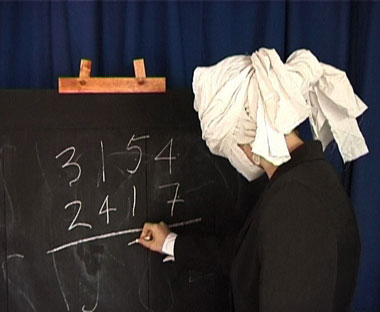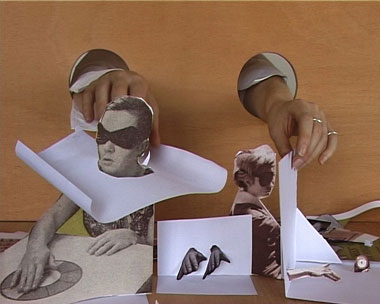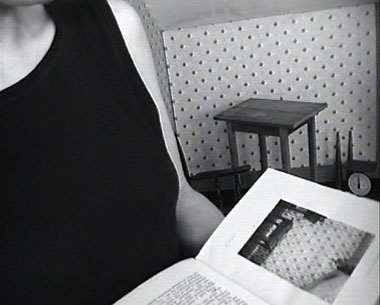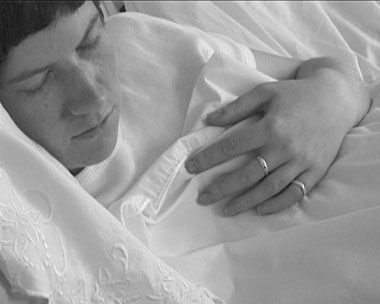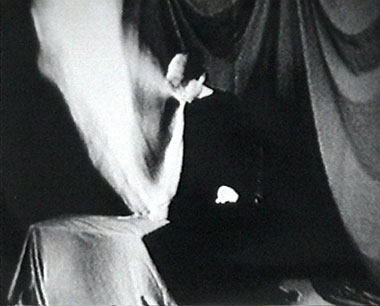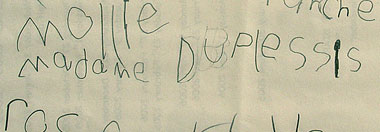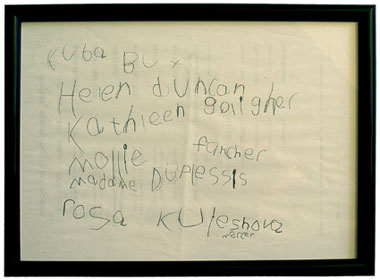Slavka Sverakova reflects on two recent works by Susan MacWilliam.
At the On the eye exhibition (2003) I was charmed by Susan MacWilliam’s video Mountain mist (2002) – a disciplined and madly beautiful seven-and-a-half minute video of Trinidad landscape. Recently, MacWilliam offered a very different charm, in an exhibition A dark noise curated by Peter Richards. 1
‘Dark noise’ is visual noise in digital imaging; it may distort an image and ought to be avoided. If, then, the artist and curator agreed on foregrounding a possible distortion, either deliberate or just not avoidable, as a dominant concept, the issue of departures, or of avoiding them, from some ideal state of phenomena appears legitimate. 2
The range of the subject matter situates the video installations into the departure category: eyeless sight, finger-tip vision, x-ray vision, séances, table tilting are both believed and unbelievable. On the face of it, this art co-habits the field occupied partly by Richard Rorty’s proposal that “ the theory of knowledge is a product of the false view that the main function of the mind is to faithfully represent a mind independent reality." 3
I confess that I have held and continue to hold that false view. I enjoy the correspondences 4 of various kinds ever since I read Charles Baudelaire. And yes, coincidences make deep inroads as they descend unexpectedly.
Dermo optics, 2006, 4mins 9secs
MacWilliam documented experiments carried at the Centre de l’Information de Couleur in Paris. Its director, Dr Yvonne Duplessis,5 is not a contemporary Mme Blavatsky, who impressed Kandinsky and Mondrian. She publishes in learned journals and reads papers at international conferences. Duplessis makes a distinction between ‘optical’ and ‘visual’ – the optical is not legible to the eye. ‘Dermal’ does not mean tactile – it can cause a reaction even if it is under a transparent or opaque screen and at a distance from the person. The intensity of the dermo-optical effect is different in daylight and in the dark; the distribution of colours is reversed, eg green produces the strongest impression and red the weakest. The most startling finding is that every subject had the same electroencephalographic results.
Early in her career, MacWilliam relied on archival evidence. This time, she makes her own ‘archive’, editing it down to manageable viewing, ie 90 minutes into 4 minutes 9 seconds. The question arises, what happens to the ‘truth’ when subjected to reduction on this scale? A common view may suspect an undesirable loss. Intriguingly, the video keeps its power of persuasion, illustrates the significance of the experiments and, importantly, inspires the viewer to fill in the connections, effortlessly. Nothing special – this is a normal process of perception and cognition. The distortion by reduction has its root in our biological ability to make sense of the world. Bypassing the demands for accuracy and for all the evidence, it dissolves rather than solves the problem of how people perceive truth. The wisdom of this art’s kernel suspends the need for ideals of perfection and for well defined standards of truth. Instead, the video creates a state of coherence among the watched experiments and among the sets of beliefs the different viewers may bring to it.
By dropping numerous frames from the documentation, MacWilliam activates the ability of the viewer to connect the disconnected and to see more than is physically, measurably there. The dominance of what is false yet captivating over what is true but dull is justified by the artist’s wish to transmit her discomfort while documenting the experiments in Paris onto a viewer:
“Regarding your question about the video Dermo optics – I sped the video up, which resulted in the subtraction of frames. The use of very fast video I saw as a way to present the huge amount of video that I had shot when I visited Madame Duplessis. I had an overwhelming experience the day I visited her and felt bombarded by information and imagery (in a good way, in an overexcited way) – I felt that the process of speeding up the video echoed my experience of the visit, in that I was having visual information endlessly presented to myself. The effect of speeding up a very long piece of footage, maybe 90 minutes into a few seconds, results in the computer losing frames – therefore we don’t see every frame – but we do get a very fast summary of everything. So, yes, frames are dropped and removed. I like how the viewers, while they can’t fix on anything, can still receive images very quickly – almost subliminally. And I like throwing all those images at the viewers so that they might feel bombarded by the stuff as I did on my visit to Madame Duplessis." 6
The departure from the expected, the distortion by reduction, achieve another member of the creative matrix: the incomprehensible makes sense autonomously. As I watched, the question of verification did not dominate my perception. The playful speed gave the video the slightly comical accent known from silent movies.
Explaining magic to Mercer, 2005, 10 min 40 sec
MacWilliam follows the early video tradition of not separating art forms: document, drawings / writings and debate are presented together. In EMM , a five-year-old boy is absorbed in drawing and writing; he asks a question not even lifting his sight from the page. A print placed beneath the image appears as MacWilliam’s answer. The voiceless answers partake in the visual power of the documenting lens, flirting with the realm of subtitles. The boy, homo faber, produces an ongoing flow of unseen marks and audible questions. 7 He is active, present, alive. The artist, in contrast, is behind the lens and behind the subtitles, her voice silenced, her answers passively static. She veils her identity with a confidence in the visual force, while discussing eyeless or x-ray vision. A paradox shadows the kindness, seriousness and subtle humour that permeates the encounter; eg the boy’s question as to how the woman can see without eyes is answered, “because her skin was covered with microscopic eyes." 8
The artist and Mercer talk about the X-ray vision of Kuda Bux (which received the Perspective 2003 Award), the ectoplasmic materialisations of Helen Duncan in The Last person (shown at the Glen Dimplex Artist Award, 1998), Mollie Fancher’s multiple personalities in The Persistence of vision, 2000, the fingertip vision of Rosa Kuleshova in Headbox, 2004, and the table-tilting done by Kathleen Goligher in Experiment M, 1999.
In the dialogue, the art is being reduced to stories; the dialogue between the visible and audible Mercer and the invisible and mute artist introduces an asymmetry charged with the unseating of an old hierarchy of values.
However, something else is going on about the comprehensible / incomprehensible duality. MacWilliam borrows what I like to call ‘tactical frivolity’, which is a form of public protest at times. In Dermo optics , this took the mode of the comical overtone created by dropped frames, in EMM it appears as the inversion – the child is visually given centre place in the interrogation of the narrative. The ‘answers’ have resulted from years of research and development of art practice. Yet they were made appear as casual reactions to the boy’s inquisitive mind.
A passion for observation enlivens the surface of the stories MacWilliam tells; however, the deep structure builds up a suspense that signals emotion, authenticity and the autonomy of art. The formation of a mental image calls for resourcefulness, for a willingness to stay in command of imagination, which I think of as a gift of nature. It lies not miles away from J S Mill’s (1806 – 1873) concern with self-development and experimentation. Perception is something we do; it is a skilful biological activity, a thoughtful activity. It is not to have a sensation, but to know something.
Giving prominence to a deviant mode of vision as a supreme theme of visual art practice forges incongruence. Furthermore, MacWilliam disrupts the documentary rhythm by a rhythm of feeling (“being bombarded"), a strategy favoured by, inter alia, Laurence Sterne in Tristram Shandy 9 and Viktor Sklovskij(1893 -1984) 10 in the so-called Russian Formalism of around 1925.
MacWilliam allows pleonasm, parallelism and inversion to frame a public discourse as a communicative action free from the steering mechanism of money and science. She locates critical thought not in historically specific socio-political contexts; the basis for discussion of the failings and the potential is ‘turnabout’ (viz G E Debord, 1931 -1994), meaning the artist reuses elements of something known to make a new work with a different message.
The subtitles in EMM appear as a jamming of MacWilliam’s speech, and the elevation of the boy’s writing into her own art practice – she framed and put on the wall of the gallery two of Mercer’s pages – connects not only to Joseph Beuys’ famous utterance (“Everyone is an artist") but also to that ‘turnabout’.
EMM ‘s title evokes Beuys’ famous performance How to explain pictures to a dead hare (1965), in which he acts like a shaman in a mask of honey and gold. The viewer can watch Beuys communicating with the animal but cannot hear what he says. By electing to be mute, MacWilliam adopts a similar strategy, intensifying it by being invisible.
Like Beuys, MacWilliam works systematically, imposing control without squashing artistic freedom. Where the older artist saw art as freedom, she looks for an autonomous status for looking, seeing, observing, and communicating. Incongruence, incompleteness, and distortion by carefully applied omissions form the navigational map for the path to the autonomy of art. Subjectivity and semiosis are not treated as context-dependent and thus continually failing. The visual force in both videos is a closed form, a muffling inclusiveness resisting dispersal in any possible context forged from the outside. The aesthetic change becomes a means of connecting with truth. If autonomy means freedom from the external authority, then it crucially depends on the capacity of an individual to make informed, uncoerced decisions, nurturing self-determined motivation and optimal functioning. It amuses me that in computing, an ‘autonomous peripheral’ is one that can be used with the computer turned off. This is similar to the magma of social significations as it allows the individual to create a stable Self and ignore the constant emergence of indeterminacy.11
Slavka Sverakova is a writer on art.

